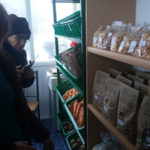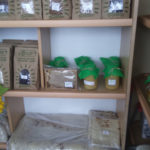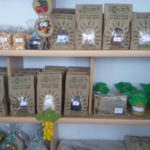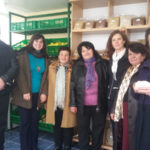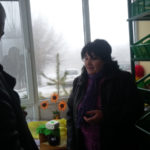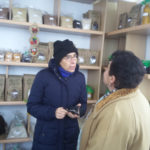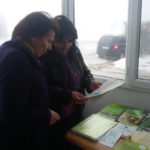Agriculture remains vital to the Armenian economy. Total arable land in Armenia stands at 14.47 %, and 1.8% is covered in permanent crops. Almost half (46%) of the workforce is employed in agriculture production. The average share of agriculture in GDP during the period of 2010-2013 was about 19%. The number of the persons employed in this sector is about 492,000 (of which 56.2 percent are female and 43.8 percent are male) and accounts for about 45 percent of the total employed population. In 1991-1992, Armenia privatized its agricultural land resources – transferring 70 per cent of all land to private ownership – which led to the creation of some 350,000 family-owned small farms with an average land-holding of around 1.4 hectares and a generally diversified production system involving both crops and livestock. Only a relatively small proportion can be considered truly commercial, and many farmers, especially those in more remote areas, are among the most vulnerable with about one-third still living in poverty. Due to the increased male outmigration, the women have to take on the additional burden of farm management. Pesticide-free agriculture is underdeveloped. The problems facing the farmers of the village of Solak in Kotayk province are a typical example of the above situation.
Objectives: – Promote pesticide-free agriculture products in Solak village of Kotayk province, Armenia.
Activities: 1. Organize a workshop for active women farmers of Solak village to develop a simple business model with a branding strategy for promotion of pesticide-free agriculture products;
a. Based on the workshop results, develop promotion materials for branding and sales
b. Develop a logo for the village products
c. Produce a banner with the logo for use at the sales area of the village;
d. Produce labels with the logo for the pesticide-free products
e. Create a sales space for the pesticide-free products (e.g. a small pavilion or a stand located at the main village road for tourists and travelers to stop and buy products
f. Create a display desk with products at the Women’s Support Center of the village
g. Create products which are special for this village and can serve as a business card of the village
h. Create a project page at the Ruraldaf webpage to inform potential customers
The village of Solak in Kotayk region is a typical example of a small village struggling to cultivate agricultural products in small farms. The village territory is 3020 sq. km. Height from sea level is 1650 m, with the continental climate. Solak is located on the bank of Hrazdan River at a distance of 12 km from the region center, 12 km from the marz center and 40 km from Yerevan. The population is 2678 people. The village has preserved the Mayravanq St. Astvatsatsin church built in the 7th century, and a castle. About 150 families live and work in abroad or get some financial support from abroad. The village has a school where 337 schoolchildren are enrolled. Hard socio-economic conditions, lack of infrastructures, limited resources and oft-occurring natural disasters such as droughts, hail, etc and incapability of poor dwellers (40 % households are needy families) of the village Solak to resist climate risks make them more vulnerable. Solak villagers are mainly engaged in cattle-breeding as well as growing vegetable and cereals. Water is supplied from the hot spring and the source of cold water, however, the village has no sewerage system.
Achieved results:
With the objective to promote pesticide-free agriculture products in Solak village of Kotayk province of Armenia, the following activities were implemented:
Activities:
A workshop was organized for women farmers members of Women’s Center. The branding strategy for promotion of pesticide-free agricultural products was discussed with rural women. The priorities were identified; the working plan was drafted.
It was agreed with rural women that they would grow products without using synthetic chemical pesticides and other agrochemicals; and work together with RURALDAF on promotion of local products.
The information materials were developed (a leaflet about local lentil with recipes of different dishes) to promote production and sales of sustainably grown local lentils in Solak community. The idea behind was further enlargement of the lands covered by lentil and development of marketing and branding approaches.
RURALDAF developed a special paper bag with a small transparent window carrying the logo “Produced in Solak” so that the women could sell different products produced in Solak. This logo is currently used as a trademark for all products produced and sold by Solak women.
A nice big banner was developed and posted on the highway Seven –Yerevan near the shop “STOP & BUY”. The banner is in English and Armenian languages and invites travelers to stop and buy locally made products, such as cereals and legumes, nuts/walnuts, vegetables, fruit, herbs, dried food and many other natural products.
Special labels were developed for different products and all of them with the logo “Produced in Solak”.
With support of AWHHE NGO and a local businessman RURALDAF set up a small shop near the road. The shop was called Healthy Stop with a slogan: Stop & Buy carrying a nice advertisement banner on the top of the shop.

Display desks (both outside and inside the shop) were created with all the products.
RURALDAF put a lot of effort into making the local lentil from Solak village recognizable. The results are very promising; the villagers were able to sell all the amount of lentil designated for sale, the rest they kept as seeding material for the upcoming season.
Information about the project is available at www.RURALDAF.am webpage.
The main beneficiaries of the project were rural women from Solak village, their families and the whole Solak community. The project was focused on rural women. About 15 women from different families were engaged in the project by learning, producing and selling. Also some men from their families were actively supporting women, sharing the work with them and helping with setup of the shop. Young volunteers also were engaged. The young girls from the village were doing handicrafts for display in the shop.
The most significant change as a result of funding was that the dream of rural women to have a space for advertising and sale of their products became a reality. The other very important achievement is that rural women started to believe on themselves and to believe that they can sell what they produce they can create a change. Rural women were stating that this project helped them in a way that now they are thinking more wise and creative way and always busy with creation of new products new way of serving their products.
At the beginning of the project RURALDAF experts organized meetings and discussions with the local growers and women farmers explaining the risks of pesticides and chemical fertilizers for producing their products. Alternative methods for pest control were introduced and the farmers agreed to avoid using pesticides and chemical fertilizers and instead to use the safe alternatives. Following the RURALDAF advice and guidance, the farmers were using plant tinctures for pest control. As fertilizers, compost and vermin compost were practiced. The farmers produced all the above alternatives themselves. The Women’s Centers served as reference point for farmers providing information and tools.
Our experts gained knowledge on branding issues of local products; we can use this knowledge in our further work to promote locally made clean rural products.
The awareness of community members on sustainable agriculture and benefits of sustainable agriculture increased. More and more community members are becoming aware and want to be involved in sustainable production of local products, especially the lentil, and to sell their products under the trademark “Produced in Solak”.
We are hopeful that next year more lentils will be seeded and the number of producers will be increased thus improving the income-generation capacities of the local farmers and enhancing their quality of life.
This project was totally designed for women. And as one of the very tangible results the coordinator of the women’s group and other women were actively involved also in the decision making process of their village such as elections of local governing bodies, public events for the day of Independence, etc.
The project had an impact on the local community development policies serving as model for engagement of women in decision-making and promotion of safe alternatives in agriculture.
An important outcome of the project was the understanding of the local decision-makers of the values of the locally grown endemic crops for sustainable development of local communities. The biodiversity is protected and at the same time local traditions are preserved. Another evidence of change is the reduction in the number of farmers who would prefer to out-migrate in search of jobs.



